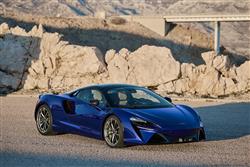SPIDER BITE (some text hidden) --NONE--
By Jonathan Crouch
The Artura Spider opens up this electrified McLaren. Jonathan Crouch takes a look.
Ten Second Reviewword count: 44
If you're sold on the idea of a PHEV supercar, then you'll find the McLaren Artura Spider difficult to resist. You can do your bit for the environment and experience more of it while doing so. What's not to like? Just the lottery-level price....
Backgroundword count: 136
So, you've chosen a cleaner Plug-in Hybrid powertrain for your supercar. And with the air a bit cleaner around you, why not pair it with an open-topped body style? Such might be your justification for this car, the McLaren Artura Spider, the brand's first drop top Hybrid. Its arrival was inevitable given Ferrari's introduction of an open top version of the Artura Coupe's arch rival, the 296 GTB. To better take on the Ferrari 296 GTS model in question, the Artura Spider's introduction coincides with a series of engineering Artura upgrades that also get applied to the Coupe version. McLaren says this is 'a no compromise open topped supercar'. But compromise is usually, at least to some extent, part and parcel of open topped sports car design. How much does that apply here? Let's find out.
Engines and Tech Specword count: 312
The engineering of course is basically the same as in the Artura Coupe. So there's no familiar twin turbo V8 nestling in the rear aluminium subframe here. Instead, we're treated to a 3.0-litre twin turbo V6, a direct injection combustion unit that's been worked on for the model year 2025 Artura, now producing 596bhp (19bhp more than the original Coupe model could offer) while revving (across a wider band) as high as 8,500rpm. The transmission (an 8-speed dual clutch gearbox that incorporates a clever e-differential and was from the Artura's launch completely new to McLaren) got revisions for its installation in this Spider model too, shifting 25% faster. As with the original Artura Coupe, there's a 94bhp axial flux e-motor that acts as a reverse gear and creates a total output that with the powertrain upgrades is rated at 690bhp, with 720Nm of torque. The basic performance stats haven't changed much, so 62mph from rest flashes by in just 3s, 124mph takes 8.3s and the top speed is 205mph. There's also an added function that allows you to spin the rear tyres up when planting the throttle from a standstill. As usual with McLaren, there are selectable handling and powertrain modes. In either case, you choose between 'Comfort', 'Sport' and 'Track', with an extra 'Electric' 'e-mode' available in the 'Powertrain' menu, allowing battery-only driving for short distances in urban travel. One feature that isn't new on this car is McLaren's trademark hydraulically-assisted steering. The brand thinks that no electric steering system can provide this set-up's level of driver feedback - and they could be right. It's combined with a bespoke version of McLaren's 'Proactive Damping System', which delivers class-leading standards of ride. Braking performance is also exceptional, thanks to carbon ceramic brakes with lightweight aluminium calipers. Get on a circuit and there's a 15-stage Variable Drift Control system to play with too.
To see the full road test text contact us on 0330 0020 227
Pictures (high res disabled)
.jpg)
.jpg)
|
.jpg)
|
.jpg)
| |||
.jpg)
|
.jpg)
|
.jpg)
| |||

|
Statistics (subset of data only)
Min |
Max |
|
Price: |
£222,760.00 (At 31 May 2024) |
|
Insurance group 1-50: |
50 |
|
CO2 (g/km): |
108 |
|
Max Speed (mph): |
205 |
|
0-62 mph (s): |
3 |
|
Combined Mpg: |
58.9 |
|
Length (mm): |
4539 |
|
Width (mm): |
2080 |
|
Height (mm): |
1193 |
|
Boot Capacity (l): |
160 |
|



